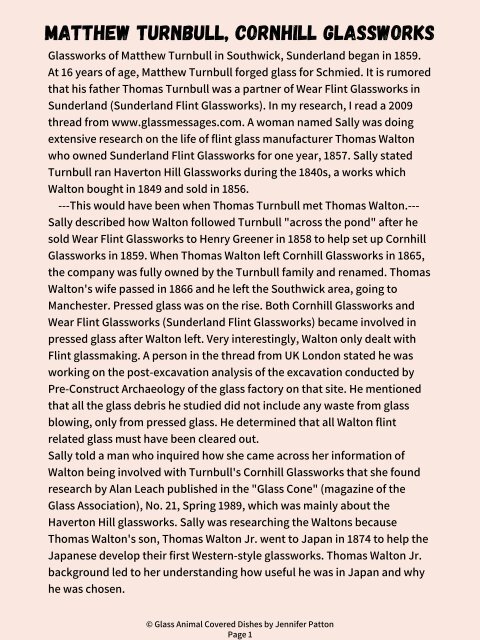Matthew Turnbull, Cornhill Glassworks
You also want an ePaper? Increase the reach of your titles
YUMPU automatically turns print PDFs into web optimized ePapers that Google loves.
© Glass Animal Covered Dishes by Jennifer Patton<br />
Page 1<br />
matthew turnbull, cornhill glassworks<br />
<strong>Glassworks</strong> of <strong>Matthew</strong> <strong>Turnbull</strong> in Southwick, Sunderland began in 1859.<br />
At 16 years of age, <strong>Matthew</strong> <strong>Turnbull</strong> forged glass for Schmied. It is rumored<br />
that his father Thomas <strong>Turnbull</strong> was a partner of Wear Flint <strong>Glassworks</strong> in<br />
Sunderland (Sunderland Flint <strong>Glassworks</strong>). In my research, I read a 2009<br />
thread from www.glassmessages.com. A woman named Sally was doing<br />
extensive research on the life of flint glass manufacturer Thomas Walton<br />
who owned Sunderland Flint <strong>Glassworks</strong> for one year, 1857. Sally stated<br />
<strong>Turnbull</strong> ran Haverton Hill <strong>Glassworks</strong> during the 1840s, a works which<br />
Walton bought in 1849 and sold in 1856.<br />
---This would have been when Thomas <strong>Turnbull</strong> met Thomas Walton.---<br />
Sally described how Walton followed <strong>Turnbull</strong> "across the pond" after he<br />
sold Wear Flint <strong>Glassworks</strong> to Henry Greener in 1858 to help set up <strong>Cornhill</strong><br />
<strong>Glassworks</strong> in 1859. When Thomas Walton left <strong>Cornhill</strong> <strong>Glassworks</strong> in 1865,<br />
the company was fully owned by the <strong>Turnbull</strong> family and renamed. Thomas<br />
Walton's wife passed in 1866 and he left the Southwick area, going to<br />
Manchester. Pressed glass was on the rise. Both <strong>Cornhill</strong> <strong>Glassworks</strong> and<br />
Wear Flint <strong>Glassworks</strong> (Sunderland Flint <strong>Glassworks</strong>) became involved in<br />
pressed glass after Walton left. Very interestingly, Walton only dealt with<br />
Flint glassmaking. A person in the thread from UK London stated he was<br />
working on the post-excavation analysis of the excavation conducted by<br />
Pre-Construct Archaeology of the glass factory on that site. He mentioned<br />
that all the glass debris he studied did not include any waste from glass<br />
blowing, only from pressed glass. He determined that all Walton flint<br />
related glass must have been cleared out.<br />
Sally told a man who inquired how she came across her information of<br />
Walton being involved with <strong>Turnbull</strong>'s <strong>Cornhill</strong> <strong>Glassworks</strong> that she found<br />
research by Alan Leach published in the "Glass Cone" (magazine of the<br />
Glass Association), No. 21, Spring 1989, which was mainly about the<br />
Haverton Hill glassworks. Sally was researching the Waltons because<br />
Thomas Walton's son, Thomas Walton Jr. went to Japan in 1874 to help the<br />
Japanese develop their first Western-style glassworks. Thomas Walton Jr.<br />
background led to her understanding how useful he was in Japan and why<br />
he was chosen.

















